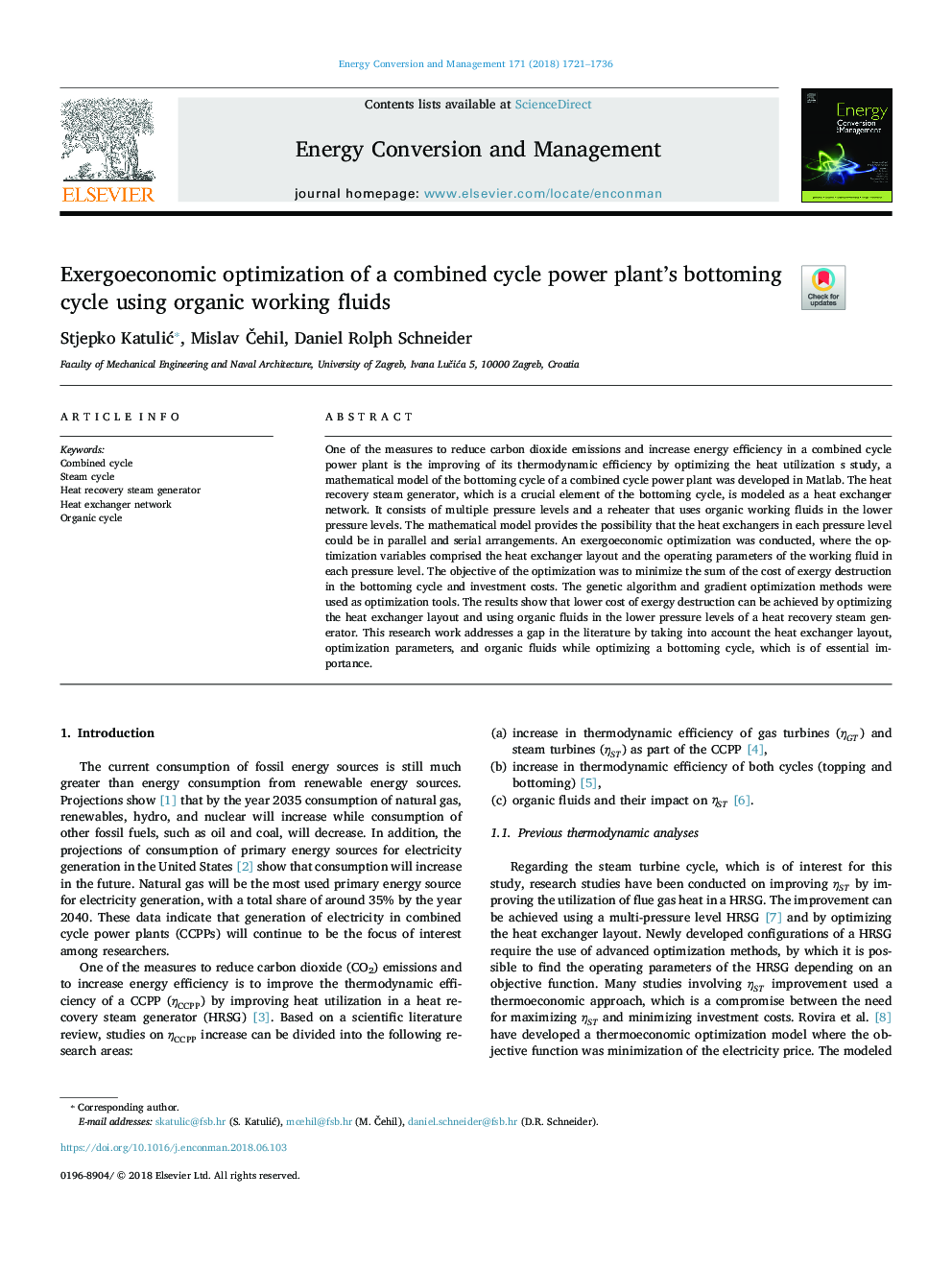| کد مقاله | کد نشریه | سال انتشار | مقاله انگلیسی | نسخه تمام متن |
|---|---|---|---|---|
| 7158113 | 1462791 | 2018 | 16 صفحه PDF | دانلود رایگان |
عنوان انگلیسی مقاله ISI
Exergoeconomic optimization of a combined cycle power plant's bottoming cycle using organic working fluids
ترجمه فارسی عنوان
بهینه سازی اگزوژیک اقتصادی چرخه پایه نیروگاه های ترکیبی با استفاده از مایعات آلی کار می کند
دانلود مقاله + سفارش ترجمه
دانلود مقاله ISI انگلیسی
رایگان برای ایرانیان
کلمات کلیدی
چرخه ترکیبی چرخه بخار، مولد بخار با توان بازیافت حرارت، شبکه مبدل حرارتی، چرخه ارگانیک،
ترجمه چکیده
یکی از اقدامات کاهش انتشار دی اکسید کربن و افزایش بهره وری انرژی در نیروگاه ترکیبی چرخه بهبود بهره وری ترمودینامیکی خود را با بهینه سازی مطالعه استفاده از حرارت، یک مدل ریاضی از چرخه پایه نیروگاه ترکیبی ترکیبی در متلب مولد بخار بازیافت بخار، که یک عنصر حیاتی از چرخه پایینی است، به عنوان یک شبکه مبدل حرارتی طراحی شده است. این شامل سطوح فشار چندگانه و یخچال است که از مایعات کار آلی در سطوح پایین فشار استفاده می کند. مدل ریاضی این امکان را فراهم می کند که مبدل های حرارتی در هر سطح فشار می تواند به ترتیب موازی و سریال باشد. بهینه سازی اگزوجیو اقتصادی انجام شد، جایی که متغیرهای بهینه سازی شامل طرح مبدل حرارتی و پارامترهای عملکرد مایع کار در هر سطح فشار بود. هدف بهینه سازی این بود که مجموع هزینه های تخریب اگزرژی را در چرخه پایینی و هزینه های سرمایه گذاری به حداقل برساند. الگوریتم ژنتیک و روش های بهینه سازی شیب به عنوان ابزار بهینه سازی استفاده شد. نتایج نشان می دهد که با بهینه سازی طرح مبدل حرارتی و استفاده از مایعات آلی در سطوح پایین تر از یک مولد بخار بازیافت حرارت، هزینه تخریب اگزرژی کاهش می یابد. این کار تحقیقاتی، شکاف در ادبیات را با توجه به طرح مبدل حرارتی، پارامترهای بهینه سازی و مایعات ارگانیک در حالی که بهینه سازی یک چرخه پایینی را که اهمیت اساسی دارد، در نظر می گیرد.
موضوعات مرتبط
مهندسی و علوم پایه
مهندسی انرژی
انرژی (عمومی)
چکیده انگلیسی
One of the measures to reduce carbon dioxide emissions and increase energy efficiency in a combined cycle power plant is the improving of its thermodynamic efficiency by optimizing the heat utilization s study, a mathematical model of the bottoming cycle of a combined cycle power plant was developed in Matlab. The heat recovery steam generator, which is a crucial element of the bottoming cycle, is modeled as a heat exchanger network. It consists of multiple pressure levels and a reheater that uses organic working fluids in the lower pressure levels. The mathematical model provides the possibility that the heat exchangers in each pressure level could be in parallel and serial arrangements. An exergoeconomic optimization was conducted, where the optimization variables comprised the heat exchanger layout and the operating parameters of the working fluid in each pressure level. The objective of the optimization was to minimize the sum of the cost of exergy destruction in the bottoming cycle and investment costs. The genetic algorithm and gradient optimization methods were used as optimization tools. The results show that lower cost of exergy destruction can be achieved by optimizing the heat exchanger layout and using organic fluids in the lower pressure levels of a heat recovery steam generator. This research work addresses a gap in the literature by taking into account the heat exchanger layout, optimization parameters, and organic fluids while optimizing a bottoming cycle, which is of essential importance.
ناشر
Database: Elsevier - ScienceDirect (ساینس دایرکت)
Journal: Energy Conversion and Management - Volume 171, 1 September 2018, Pages 1721-1736
Journal: Energy Conversion and Management - Volume 171, 1 September 2018, Pages 1721-1736
نویسندگان
Stjepko KatuliÄ, Mislav Äehil, Daniel Rolph Schneider,
